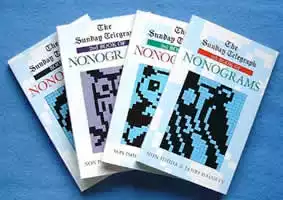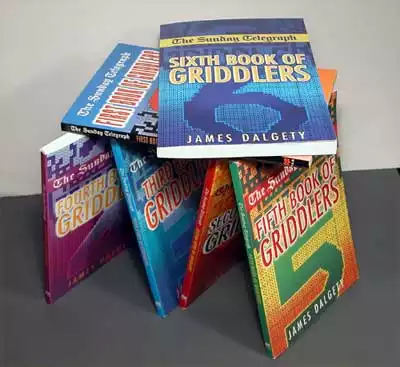Grids with pictures have been used in puzzles for many years. Early Crosswords often used pictures as part of their layout. Stephenson's Train (above) is a nice example published in Italy in 1925. Grids using cross reference to deduce the contents also have a long history. Trevor Truran's "Whittleword" from Games & Puzzles Magazine Issue 73 Summer 1979 is one such. However the Griddler type of puzzle is new in the way that the cross-reference is used to calculate the picture on the grid.
In 1987, Non Ishida, a Japanese graphics editor, won a competition in Tokyo by designing grid pictures using skyscraper lights that were turned on or off. Coincidentally, a professional Japanese puzzler named Tetsuya Nishio invented the same puzzles.
Paint by numbers puzzles started appearing in Japanese puzzle magazines. Non Ishida published three picture grid puzzles in 1988 in Japan under the name of "Window Art Puzzles". Subsequently in 1990, James Dalgety in the UK invented the name Nonograms after Non Ishida, and The Sunday Telegraph started publishing them on a weekly basis.

By 1993, First book of Nonograms was published by Non Ishida in Japan. The Sunday Telegraph published a dedicated puzzle book titled the "Book of Nonograms". Nonograms were also published in Sweden, United States (originally by Games magazine), South Africa and other countries. The Sunday Telegraph ran a competition in 1998 to choose a new name for their puzzles. Griddlers was the winning name that readers chose.

Electronic puzzles
Paint by numbers puzzles were implemented by 1995 on hand held electronic toys such as Game Boy and on other plastic puzzle toys. Nintendo picked up on this puzzle fad and released two "Picross" (Picture Crossword) titles for the Game Boy and nine for the Super Famicom (eight of which were released in two-month intervals for the Nintendo Power Super Famicom Cartridge Writer as the "NP Picross" series) in Japan. Only one of these, Mario's Picross for the Game Boy, was released outside of Japan. Another version, Picross DS was released in 2007. Another downloadable version was also released for Nintendo 3DS's Nintendo eShop, called Picross e & Picross e 2, both released in 2013. Increased popularity in Japan launched new publishers and by now there were several monthly magazines, some of which contained up to 100 puzzles. The Japanese arcade game Logic Pro was released by Deniam Corp in 1996, with a sequel released the following year. UK games developer Jagex released a nonogram puzzle in 2011 as part of their annual Halloween event for their java based game, Runescape. In 2013, Casual Labs released a mobile version of these puzzles called "Paint it Back" with the theme of restoring an art gallery.